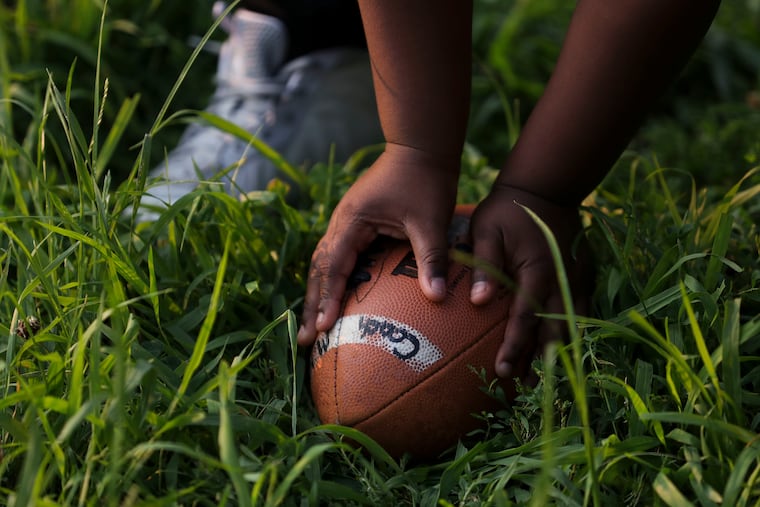How to protect kids who play football from head injuries
No matter what sport they play or what community they play in, youth athletes must have the same level of concussion care.

It’s a Saturday morning. You’re sitting in a row of bleachers cheering on your Little League athlete during their community youth football game with the rest of the parents. This is game three out of four that day, and each game has become more physical with the increase in age bracket.
The quarterback passes the ball to your athlete, who gets tackled to the ground after making the catch. You watch and wait for your player to get up. Five seconds go by and nothing. Your player is now on the field, seizing. Players, coaches, and you rush over, only for the day to turn into your worst nightmare. Hours later, your 10-year-old athlete is pronounced brain-dead at the local hospital.
These are the stories that make headlines, the stories that draw attention to the growing public health problem of sports-related concussions and traumatic brain injuries. And if you’re an NFL fan, you’ve heard a similar, albeit less extreme, story related to the concussion management of Miami Dolphins quarterback Tua Tagovailoa.
While serious, these devastating events are rare for youth athletes. Less than one in every 100,000 youth athletes had a direct fatality due to football in 2014, according to an annual football survey. Compare that with the 1,093 children under age 14 in the U.S. who died in traffic crashes in 2020.
More commonly, a child involved in a contact sport suffers a head injury and experiences mild symptoms such as headaches, fatigue, and irritability that can last multiple days to weeks. These symptoms can be persistent — leading to post-concussion syndrome. Yet, I’ve seen these kids return to the game, play after play, probably sooner than they should.
Ensuring that appropriate concussion management is reaching these children is paramount. As someone who grew up in a sports family attending many youth football games, I know that it’s important we prevent both the rare and common outcomes of concussions. One way to do this is by reforming our Pennsylvania return-to-play laws, which would increase concussion awareness and education in community sports organizations.
More than one million children and young adults in the U.S. experience a sports-related concussion every year. Although pediatric concussion rates in emergency departments across the country decreased during COVID-19, sports-related concussions will soon be on the rise with the return of youth community sports in the “post-COVID-19″ era.
To prevent long-lasting concussion symptoms, health policy and awareness campaigns have been implemented within the last two decades. Return-to-play laws were enacted in all 50 states and the District of Columbia between 2009 and 2014. These laws aim to educate individuals about concussion management, remove athletes from play when a concussion is expected, and require permission from a health-care professional before an athlete can get back on the field. Additionally, the Centers for Disease Control and Prevention created education initiatives such as the HEADS UP program to increase awareness about sports concussion management through free online resources.
As great as these efforts are, is there a trickle-down effect of concussion awareness, education, and management to community youth sports organizations? Not so much, especially in underresourced communities where disparities exist in youth sports, including inequalities related to concussion management.
Not all state laws addressing youth sports-related concussions apply to recreational sports. Pennsylvania’s return-to-play law, under the Safety in Youth Sports Act, only applies to school-organized and college sports. There is no requirement or oversight of concussion education and management in community sports. And community youth sports organizations in underresourced areas are often at greater risk of having poor concussion management amongst their athletes. Specific challenges include the cost of educational materials and training and limited access to follow-up care.
Sports are unequal in many ways, but all kids who play contact sports deserve to have access to the best concussion management protocols. Mandating that all state return-to-play laws include recreational youth sports would help to reduce these disparities. The mandate would incentivize community sports organizations to prioritize concussion management training and take advantage of open-access resources like the HEADS UP program and other state-funded programming found on the Department of Health and Department of Education websites.
Public health laws mean nothing if their impact is not felt by the target population. We need to make sure that every youth athlete, no matter what sport they play or what community they play in, has the same level of concussion care.
Canada Montgomery is a fourth-year medical student and associate fellow at the Leonard Davis Institute of Health Economics at the University of Pennsylvania. She is a football enthusiast hoping to advocate for athletes with traumatic brain injuries as a future neurosurgeon. @CanadaTMonty
Editor’s note: An earlier version of this article misstated the number of children under 14 who died in traffic crashes in 2020.